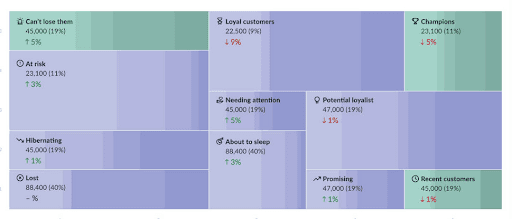Segmentation Strategies in Klaviyo: Tailoring Your Messages for Maximum Impact

What is segmentation in Klaviyo?
Just how important is segmentation, and why should you care about it? Research shows that segmentation makes companies 60% more likely to understand their customers’ concerns and 130% more likely to know their motivations, helping such businesses exceed their lead generation and revenue goals.
Segmentation forms the basis for delivering targeted and relevant messages to customers by splitting your prospects into smaller groups of people with shared characteristics. Klaviyo offers a powerful array of tools and segmentation features that help you break down your Klaviyo email list into smaller, more targeted groups and craft targeted messages that resonate with them.
In this blog post, we walk you through these segmentation strategies in Klaviyo. We also guide you on tailoring your messages for maximum impact.
In Klaviyo, segmentation is a powerful tool that lets you divide your email list into smaller, more targeted groups based on specific shared characteristics.
Instead of blasting the same message to everyone, you can personalize your communications to resonate with each group's needs and interests, leading to higher engagement and conversion rates.
Here’s some perspective: suppose you have an online clothing store selling swimwear and winter coats. You wouldn't send the same promotional email about beach towels to someone who just bought a down jacket, right? Segmentation allows you to avoid such mismatches.
How segmentation works in Klaviyo
Klaviyo has classifications called segments that make it easy to group your customers based on shared characteristics to make your campaigns more targeted.
These segments can be brand-specific or item-specific and consist of customers who visit your site for a specific product or product type. These classifications help narrow your audience by interest, guiding the content you generate to appeal to them specifically.
Klaviyo makes it easy to create and manage segments. You can use the drag-and-drop interface to build segments based on any of its specified criteria or use its predictive analytics to create segments based on people's future behavior.
Once you've created a segment, you can use it to send targeted email campaigns, Klaviyo SMS campaigns, or even Facebook ads.
Klaviyo makes it easy to track the performance of your segments so you can see how effective they are at achieving your marketing goals.
Segments are different from traditional subscriber lists in that a set of conditions defines them. They are dynamic and grow as more people meet each group's conditions and shrink as people cease to meet them.
On the other hand, traditional lists are static and grow as more people subscribe or are manually added.
Effective Segmentation Strategies in Klaviyo
While segmentation may take some effort to implement correctly, it pays off. Highly segmented campaigns earn higher open rates and CTR (click-through rates) and generate more revenue per recipient.
With effective segmentation strategies, your campaigns can return more than three times the revenue per recipient of unsegmented lists: $0.19 versus $0.06.
Let’s look closely at some effective segmentation strategies in Klaviyo to maximize the impact of your Klaviyo SMS and email marketing efforts.

1. Demographic Segmentation
Men and women have different needs, preferences, and purchasing habits. So do younger and older customers. Therefore, the first strategy is to classify your target market into males, females, and various age groups.
Classifying your lists in terms of age and gender will let you tailor your marketing message and content to be more relevant to each group. You can tailor your offers more appropriately to specific demographics, like showcasing summer trends to vibrant young adults and offering back-to-school deals to parents.
Other demographics include job titles, income levels, and other similar characteristics. These will help make your offers more suitable and meaningful to specific groups based on their purchasing power and interests.
2. Geographic segmentation
The other essential demographic to consider in your Klaviyo email and SMS strategy is the location. This usually goes hand in hand with the other demographics discussed above but can be approached separately.
Place people from specific locations together to tailor promotions and marketing content to local preferences.
Segmenting customers by location allows you to run geotargeted promotions and local outreach.
Such location-based segments help you achieve the following:
Send personalized messages with local appeal tailored to each region.
Offer geography- or location-specific discounts and promotional incentives.
Promote regional events more efficiently and with greater impact.
Use location-based data to gain insight into specific consumer behavior and buying patterns specific to certain areas.
3. Behavioral Segmentation
As the name suggests, behavioral segmentation leverages customer behavior, such as past purchase history and frequency, website activity, and email engagement.
Consider the customers’ past purchases, frequency, total spent, and product categories to make sense of what they’re interested in, how much they can spend, and how often they require the product.
This information should give you a picture of the customers belonging to a certain group. Here, you should have classifications like first-time buyers, repeat customers, and high spenders).
Once you have these classifications, craft and send targeted offers, upsell and cross-sell recommendations, and offer exclusive deals according to the group’s characteristics.
Regarding website activity, consider page views, downloads, cart abandonment, and time spent. Tracking these signals should give you an idea of who to target with win-back messages and promotions and who to approach with new product recommendations.
For instance, you will want to direct win-back emails to abandoned carts and personalized product recommendations to various groups based on their browsing history. The browsing history tells you precisely what the customer is interested in.
Email engagement data should include open rates, click-through rates, unsubscribes, and time since the last opening. Here, you can craft re-engagement campaigns for inactive subscribers, offer exclusive content to highly engaged segments, and tailor the frequency of emails based on individual engagement levels.
4. Customer Lifetime Value (CLTV) Segmentation
Let's face it: not all customers spend the same amount on your shop. Some high-spenders give your business more value than average spenders.
To segment your customers based on their lifetime value, start by identifying the various customer groups based on their value to your business.
The first group should be the high-value customers (VIPs). These are the high spenders with the highest CLTV (customer lifetime value) for your business. Treat them like royalty with exclusive offers, early access to new products, and personalized birthday greetings.
The next group consists of frequent purchasers. These may not be top spenders, but their lifetime value is high as they constantly pour money into your business. Reward them with discounts, send them thank you emails, and offer them loyalty programs.
New customers are another priority area. You want to nurture them into return customers, so ensure you target them with welcome series, educational content, and introductory offers. Ensure you provide your new customers with valuable resources to encourage repeat purchases.
You don't want to lose any customers. So, pay attention to at-risk customers, the type that abandons carts. Target them with win-back campaigns and appealing re-engagement incentives.
Finally, there are the mid-tier customers. This customer group requires nurturing with targeted discounts, educational content, and invitations to exclusive events.
5. Psychographic Segmentation
You can segment your customers based on their interests and preferences. How do you identify such psychographic signals? Look for feedback on product reviews to learn about the customers’ preferences and interests.
You can also conduct surveys and sample the responses. Your business Facebook page, Instagram, and other social media channels are all valuable sources of Kalviyo tips for psychographic segmentation.
Once you have this information, use it to send personalized content and recommendations to the various customer groups.
6. Dynamic Segmentation
Klaviyo has dynamic segments that update automatically based on customer behavior. These allow you to target customers at the right moment with relevant messages. For example, you can send a win-back email to customers who abandon their cart through your dynamic segments.
The real power of Klaviyo's dynamic segments lies in their real-time data. Such data allows you to capture customers at the most opportune moment with personalized messages based on their current behavior and interests.
7. Cross-channel segmentation
Klaviyo's segmentation features extend beyond email marketing. Use your segments for targeted Facebook and Instagram ads, SMS campaigns, and personalized push notifications in your mobile app.
The beauty of cross-channel segmentation is how it allows you to get creative with the power of Kalviyo API. The tool allows you to implement Klaviyo integrations that help carry your marketing message across various channels.
Notice that Klaviyo segments themselves do not directly involve integrations. However, several Klaviyo integrations can support and enrich your segmentation strategies through data and functionality, allowing you to target customers across email, social media, and SMS.
By combining different data points, you can create even more targeted segments. Let’s look at this more closely with an example: suppose you have customers who bought a product and haven't opened your emails in a month; you can create their segment and send them a win-back email with a special offer on a related product.
Klaviyo Tips To Tailor Your Messages for Maximum Impact
Now that we have the segmentation strategies in Klaviyo out of the way let's get some Klaviyo tips to help you create high-performing segments and send more relevant emails.
Start your segmentation process with a clear goal for each segment and design it around that goal. For instance, are you looking to increase sales, brand awareness, engagement, or something else? You can easily choose the right segmentation criteria once you define this Klaviyo SMS and email marketing goal.
Layer your segments by combining different criteria (the various segmentation strategies shared above) to create even more targeted segments. For example, you could segment by purchase history and then further by location.
Start simple. Do not overwhelm yourself with complex segments at first. Instead, begin with basic segments based on purchase history, website behavior, or demographics before getting too granular.
Go beyond the basics later in your segmentation journey. After starting simply, you will gradually get comfortable. That’s the point to start incorporating more sophisticated data points like customer lifetime value (CLTV), predicted revenue, and engagement scores.
Leverage Klaviyo's built-in features like ‘Define with AI’ and ‘Flow’ to automate your segmentation and campaign creation.
Track and analyze the results to refine your segments. Some segments may not hit the mark the first time, but you can test and refine them down the line for better results. So, track your segments' performance and experiment with different criteria and messaging to see what resonates best with each group.
Recap of Segmentation Strategies in Klaviyo
So, in this write-up, we have learned that Klaviyo has classifications called segments that make it easy to group your customers based on shared characteristics to make your campaigns more targeted and impactful.
We have learned how segmentation works and identified the following segmentation strategies in Kaviyo:
Demographic Segmentation
Behavioral Segmentation
Customer Lifetime Value (CLTV) Segmentation
Psychographic Segmentation
Dynamic Segmentation
Cross-channel segmentation
In our next blog post, we will walk you through building your first email campaign with Klaviyo.
If you need help implementing the Klaviyo segmentation strategies in this discussion, our Klaviyo experts in Los Angeles can help. Schedule a free consultation call to discuss your options.
